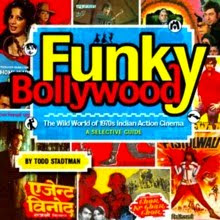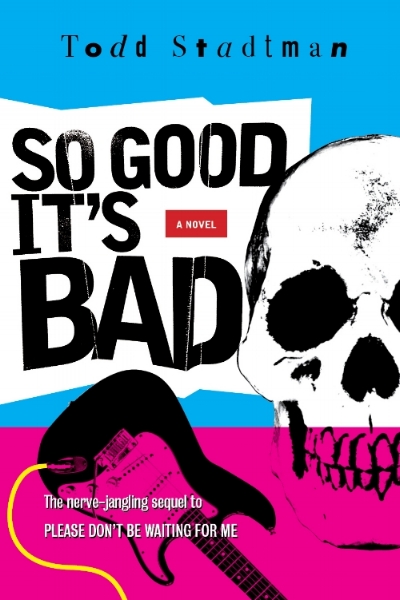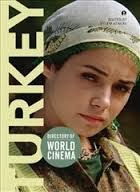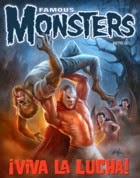One of the Mexican film industry’s worst kept secrets is how, during the 1960s and 70s, its B movies were sometimes spiced up for export with nude and softcore content that never would have flown past the censors at home. Probably the most well known of these “sexo” versions is
Night of the Bloody Apes, the English dubbed cut of
El Horripilante Bestia Humana, a Rene Cardona “Wrestling Women” type film that made its stateside debut augmented by copious T&A, riotously fake but nonetheless disgusting gore, and some bloody footage of an actual surgical procedure. More notorious, however, is the nude version of another Cardona film,
Santo en el Tesoro de Dracula, which was retitled
El Vampiro y El Sexo -- primarily because it is the rare Santo film with titties in it, and also because, for most of the time it has been known to exist, it has been near impossible to see. That is, UNTIL NOW…
As Santo films go, the non-sexy
El Tesoro de Dracula is unremarkable but not awful. For me, the best thing about it is that, in it, Santo invents a time machine that runs on the scientific principal of reincarnation. Santo also has one of his best comic relief sidekicks in Percito (Alberto Rojas), who, despite acting like Jerry Lewis, looks like a Mexican hipster version of Flavor Flav, right down to his giant dollar sign medallion, and whom Santo treats with undisguised contempt throughout the entire picture. Fortunately, these elements all remain in
El Vampiro Y El Sexo, as this version has no other agenda than to add sexiness to what has already been provided.
As
El Vampiro begins, Santo’s pal, the nuclear physicist Dr. Sepulveda (Carlos Agosti), is pitching Santo’s latest invention to a group of his scientist friends. They scoff, as well they should. The time machine, which Santo claims will dematerialize a person and rematerialize them in a past life, remains untested due to Santo being unable to find the proper subject, whom he describes as “a young person, preferably female”. All of this makes Santo sound like he conceived of the whole idea while on the receiving end of an especially tight choke hold. Still, the Silver Mask is nonetheless butt hurt by the rejection, causing his girlfriend, and Sepulveda’s daughter, Luisa (Noelia Noel) to take pity on him and volunteer for the job.
Once she has donned her shiny time travel suit and traveled through the swirly peppermint center of Santo’s time portal, we find that Luisa is somehow the reincarnation of a fictional character from the novel
Dracula. Instantly clad in a see-through nightie, she lands in the late 19th century bedroom of her ancestor Luisa Soler and is overcome with the vapors. Downstairs, her father, Professor Soler (Jorge Mondragon), consults with the Germanic Professor Van Roth (Fernando Mendoza) about her condition. It seems she is showing symptoms similar to those of several other women in the village, one of whom, Luisa’s friend Mara, has taken to appearing as a mysterious “Lady in White” and biting small children. And then Aldo Monti of
Santo y Blue Demon contra Dracula y el Hombre Lobo shows up in the role of “Count Alucard” and we begin to get the picture.
And if the significance of that name escapes you, let me help you out:
Seriously, one wonders how many iterations Dracula toyed with before settling on that backwards pseudonym. Was it before or after he tried spelling his name with anarchy symbols on his trapper keeper?
Anyway, so, yeah, Luisa, unknown to her loved ones, is under the sway of the Prince of Darkness – which means, in
El Tesoro de Dracula, that he is slowly draining her blood, but, in
El Vampiro y El Sexo, that he does so only after fondling her naked boobs a whole bunch. Dracula also has a sextet of brides whom he has hidden away in a crypt somewhere, and these conform to vampire canon only to the extent that you’d be willing to accept Blaze Starr as a wraithlike creature of the night. These are seriously top heavy women we’re talking about, making it less remarkable that they appear topless to such a great extent than that they are even capable of wearing tops at all.
By the way, throughout all of this, Santo, Percito, and Dr. Sepulveda are watching all of the action transpire on a black and white television that somehow allows them to watch things that happened in a distant, pre-technological age. In other words, this means that Santo is sitting on his ass watching the first half of
El Vampiro y El Sexo roll perplexingly by just like we are. Unlike us, though, Santo is a man of action, and events ultimately take a turn that demand his involvement. This occurs as
El Vampiro y El Sexo continues to follow the template set by the original
Dracula, with Professor Van Roth preparing to put a stake through the vampirized Luisa’s heart. Santo zaps her back into the present day post haste, freeing up the film to become a more prosaic Santo adventure for most of its remaining running time.
From here on out, Santo becomes locked on the idea of uncovering the vast ancestral treasure he heard Dracula speak of during the time he was just watching
El Vampiro y El Sexo on TV (and, to his credit, he admits that part of his reason for wanting to do this is to prove to those asshole scientists at the beginning of the movie that he was right). The key to finding it are coded symbols found on a medallion and ring that adorn Dracula’s corpse, which complicate things once a mysterious figure called the Black Hood ends up in possession of the ring. It turns out, however, that one of the Black Hood’s minions is a wrestler by the name of Atlas (Victor Manuel Gonzales), and the two sides agree to settle the matter in the ring. This leads to one of the rare instances in which an elongated wrestling sequence in a Santo movie actually moves its plot forward. Once the matter is settled, Dracula briefly returns to touch on Noelia Noel’s boobs a bit more before being vanquished.
My understanding is that among the final hurdles to us all basking in the glory that is
El Vampiro y El Sexo were the legal efforts of Santo’s son, El Hijo del Santo, who feared that the film, if unearthed, would besmirch his dad’s good name. While I respect his sense of filial duty, having seen the film, I don’t think he has that much to worry about. For one thing, at no point in the film does Santo appear in any actual proximity to a naked woman, making it conceivable -- although I don’t know how likely – that the edits could even have been made without his knowledge. Secondly, when compared to the more conspicuously sleazy
Night of the Bloody Apes,
El Vampiro y El Sexo comes off as relatively innocent, replacing that film’s troubling misogyny with an adolescent boob fixation that is at worst a little annoying and embarrassing coming from grown men.
As for me, while calking some of the cracks in my Santo scholarship, finally seeing
El Vampiro y El Sexo didn’t turn out to be much of a touchstone event, though I’m nonetheless glad to have it behind me. Granted, more such lucha films turned
sexo are rumored to exist, which means I might be treading this ground again sooner than good sense would recommend.


















































































